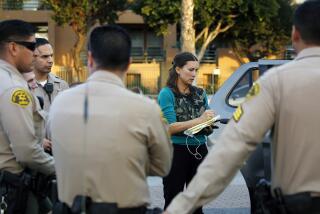New York Times Explains, Critiques Its Lee Coverage
- Share via
The New York Times published an extraordinary, 1,600-word “public accounting” Tuesday of its controversial coverage of the case against Wen Ho Lee, the nuclear scientist who was released from prison Sept. 13 after the government dropped 58 of 59 felony counts against him.
In releasing Lee, U.S. District Judge James A. Parker apologized to him for his nine months of incarceration and chastised the Clinton administration for having “embarrassed this entire nation” with its handling of the case.
New York Times coverage of the case began with a Page 1 story on March 6, 1999, that said China had made “a leap in the development of [its nuclear weapons]” with the aid of stolen American secrets. The story said that the FBI had focused its suspicions on a Chinese American scientist at the Los Alamos National Laboratory. Although the story did not name the suspect, the Energy Department fired Lee two days later for “serious security violations.” Lee was named in all subsequent stories.
In a Page 2 story under the heading “From the Editors: The Times and Wen Ho Lee,” New York Times editors said critics “contended that our reporting had stimulated a political frenzy amounting to a witch hunt.” The story noted that after Lee’s release the White House also had criticized the media, “and specifically the New York Times, for having propelled an overzealous prosecution by the administration’s own Justice Department.”
The newspaper defended itself, saying that it had “neither imagined the security breach nor initiated the case against Wen Ho Lee.” After examining the paper’s coverage, the editors said: “On the whole, we remain proud of work that brought into the open a major national security problem of which officials had been aware for months, even years.”
But the editors acknowledged several flaws in their coverage.
“We could have pushed harder to uncover weaknesses in the FBI case against Dr. Lee,” they wrote.
The editors said the March 6 story “did not pay enough attention to the possibility that there had been a major intelligence loss in which the Los Alamos scientist was a minor player, or completely uninvolved.”
“The Times should have moved more quickly to open a second line of reporting, particularly among scientists inside and outside the government,” Tuesday’s story said. The paper was also guilty of occasionally replacing “a tone of journalistic detachment” with language that “adopted the sense of alarm” voiced by others, it said.
“In those instances where we fell short of our standards in our coverage of this story, the blame lies principally with those who directed the coverage for not raising questions that occurred to us only later,” the editors said of their own role. “Nothing in this experience undermines our faith in any of our reporters, who remained persistent and fair-minded in their news-gathering in the face of some fierce attacks.”
Tuesday’s article was the latest, and most extensive, manifestation of a policy that began in 1983, when New York Times editors decided to publish periodic “editor’s notes” to explain errors that could not be properly addressed in the paper’s traditional “corrections” column.
Joseph Lelyveld, executive editor of the paper, said that he and Managing Editor Bill Keller were the principal authors of the story. In the course of writing it, he said in an interview, the two editors “consulted with everyone involved in the coverage.”
The purpose of the story, he said, was not to serve as a complete reconstruction of New York Times coverage or to be a response to media critics but to “speak to our readers . . . we thought might be confused and worried that we were in some kind of defensive crouch.”
Reaction was mixed.
“I think this is the most extensive and personally anguished explanation the Times has ever run trying to talk about . . . what they did wrong and what they wish they had done,” said Jim Naughton, president of the Poynter Institute for Media Studies in St. Petersburg, Fla. “It . . . ascribes the shortcomings to the editors and illuminates the journalistic process in a way that I hope sets a precedent for others of us in journalism who have historically been much too defensive when what we’ve done has been criticized.”
Others, however, found the “from the editors” story inadequate.
“For the Times, it was an absolute screaming confession, but I thought it was a very defensive and strange and inconsistent piece,” said Everett Dennis, director of the Center for Communications at Fordham University in New York. “I thought they didn’t clearly acknowledge what the specific criticisms of their coverage had been. Instead of saying they did anything wrong, they mostly said they should have done more.”
More to Read
Sign up for Essential California
The most important California stories and recommendations in your inbox every morning.
You may occasionally receive promotional content from the Los Angeles Times.













